Smart Cruise Control operation
Operating conditions for basic function
Basic function
Smart Cruise Control operates when the following conditions are satisfied.
-
The gear is in D (Drive)
-
Your vehicle speed is within the operating speed range
-
10~160 km/h (5~100 mph): when there is no vehicle in front
-
0~160 km/h (0~100 mph): when there is a vehicle in front
-
-
ESC (Electronic Stability Control) or ABS is on
-
Smart Cruise Control does not operate in the following conditions.
-
The driver's door is opened
-
Engine RPM is high
-
EPB (Electronic Parking Brake) is applied
-
ESC (Electronic Stability Control) or ABS is controlling the vehicle
-
Forward Collision-Avoidance Assist brake control is operating

When stopped behind another vehicle, the driver can turn on Smart Cruise Control while the brake pedal is depressed.
Operating conditions for Acceleration Assist
Overtaking Acceleration Assist will operate when the turn signal indicator is turned on to the left while Smart Cruise Control is operating, and the following conditions are satisfied:
-
Your driving speed is above 60 km/h (40 mph)
-
A vehicle is detected in front of your vehicle
Overtaking Acceleration Assist does not operate in the following conditions.
-
The hazard warning flasher is on
-
Vehicle speed is reduced to maintain distance with the vehicle in front

When the turn signal indicator is turned on to the left while there is a vehicle ahead, the vehicle may accelerate temporarily. Pay attention to the road conditions at all times.
Regardless of your country's driving direction, Overtaking Acceleration Assist will operate when the conditions are satisfied. When using the function in countries with different driving direction, always check the road conditions at all times.
Turning on Smart Cruise Control
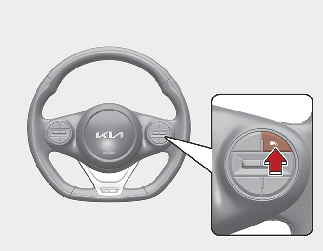
Press the Driving Assist button to turn on Smart Cruise Control. The speed will be set to the current speed on the cluster.
-
If there is no vehicle in front of you, the set speed will be maintained.
-
If there is a vehicle in front of you, the speed may be adjusted to maintain the distance to the vehicle ahead. If the vehicle ahead accelerates, your vehicle will travel at a steady cruising speed after accelerating to the set speed.

-
If your vehicle speed is between 0~30 km/h (0~20 mph) when you press the Driving Assist button, the Smart Cruise Control speed will be set to 30 km/h (20 mph).
-
If the driver changes to the lower gear, the driving speed may not reach the set speed.
Setting vehicle distance
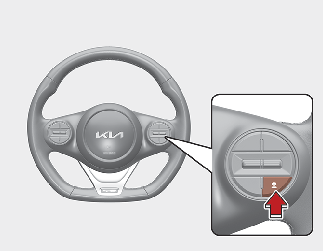
Each time the button is pressed, the headway changes as follows:


-
If you drive at 90 km/h (56 mph), the distance is maintained as follows:
Distance 4 - approximately 52.5 m (172 ft.)
Distance 3 - approximately 40 m (130 ft.)
Distance 2 - approximately 32.5 m (106 ft.)
Distance 1 - approximately 25 m (82 ft.)
-
The distance is set to the last set distance when the vehicle is restarted, or when Smart Cruise Control was temporarily canceled.
Increasing set speed
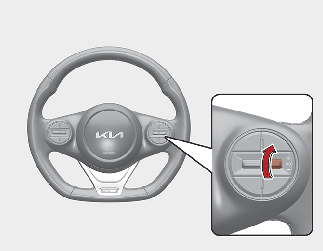
-
Push the (+) switch up and release it immediately. The set speed will increase by 1 km/h (1 mph) each time the switch is operated in this manner.
-
Push the (+) switch up and hold it. The set speed will increase by 10 km/h (5 mph) each time the switch is operated in this manner.
You can increase the set speed to 180 km/h (110 mph).

Check the driving condition before using the (+) switch. Driving speed may sharply increase when you push up and hold the (+) switch.
Decreasing set speed

-
Push the (-) switch down and release it immediately. The set speed will decrease by 1 km/h (1 mph) each time the switch is operated in this manner.
-
Push the (-) switch down and hold it. The set speed will decrease by 10 km/h (5 mph) each time the switch is operated in this manner.
You can decrease the set speed to 30 km/h (20 mph).
Temporarily canceling Smart Cruise Control
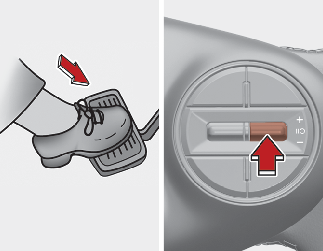
Press the ( ) switch or depress the brake pedal to temporarily cancel Smart Cruise Control.
) switch or depress the brake pedal to temporarily cancel Smart Cruise Control.
Resuming Smart Cruise Control
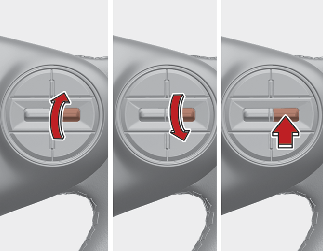
To resume Smart Cruise Control after the function was canceled, operate the (+), (-) or ( ) switch.
) switch.
If you push the (+) switch up or (-) switch down, the set speed will be set to the current speed on the cluster.
If you press the ( ) switch, vehicle speed will resume to the preset speed.
) switch, vehicle speed will resume to the preset speed.

Check the driving condition before using the ( ) switch. Driving speed may sharply increase or decrease when you press the (
) switch. Driving speed may sharply increase or decrease when you press the ( ) switch.
) switch.
Turning off Smart Cruise Control

Press the Driving Assist button to turn Smart Cruise Control off.

If your vehicle is equipped with Manual Speed Limit Assist, press and hold the Driving Assist button to turn off Smart Cruise Control. However Manual Speed Limit Assist will turn on.

Do not use the switches and buttons at the same time. Smart Cruise Control may not operate properly.
Displaying operating status
You can see the status of the Smart Cruise Control operation in the Driving Assist view on the cluster. Refer to More Details.
Smart Cruise Control will be displayed as below depending on the status of the function.


Smart Cruise Control will be displayed as below depending on the status of the function.
-
When operating
-
Whether there is a vehicle ahead and the selected distance level
-
Set speed
-
Whether there is a vehicle ahead and the target vehicle distance
-
-
When temporarily canceled
-
Vehicle (shaded)
-
Previous set speed (shaded)
-

-
The distance of the front vehicle on the cluster is displayed according to the actual distance between your vehicle and the vehicle ahead.
-
The target distance may vary according to your driving speed and the set distance level. If your driving speed is low, even though the vehicle distance have changed, the change of the target vehicle distance may be small.
-
The images and colors in the instrument cluster may differ depending on the cluster type or theme selected from the settings menu.
Accelerating temporarily
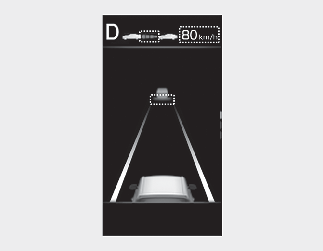
If you want to speed up temporarily without altering the set speed while Smart Cruise Control is operating, depress the accelerator pedal. While the accelerator pedal is depressed, the set speed, distance level and target distance will blink on the cluster.
However, if the accelerator pedal is depressed insufficiently, the vehicle may decelerate.

Be careful when accelerating temporarily, because the speed and distance is not controlled automatically even if there is a vehicle in front of you.
Temporarily canceling Smart Cruise Control
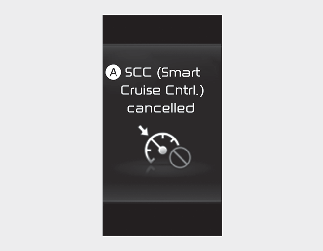
A: SCC (Smart Cruise Control.) cancelled
Smart Cruise Control will be temporarily canceled automatically when:
-
The vehicle speed is above 190 km/h (120 mph)
-
The vehicle is stopped for a certain period of time
-
The accelerator pedal is continuously depressed for a certain period of time
-
The conditions for the Smart Cruise Control to operate is not satisfied
If Smart Cruise Control is temporarily canceled automatically, the warning message will appear on the cluster, and an audible warning will sound to warn the driver.

If Smart Cruise Control is temporarily canceled while the vehicle is at a standstill with the function activated, EPB (Electronic Parking Brake) maybe applied.

When Smart Cruise Control is temporarily canceled, distance with the front vehicle will not be maintained. Always have your eyes on the road while driving, and if necessary, depress the brake pedal to reduce your driving speed in order to maintain a safe distance.
Smart Cruise Control conditions not satisfied
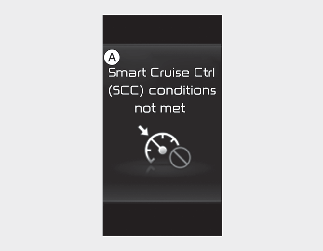
A: Smart Cruise Ctrl (SCC) conditions not met
If the Driving Assist button, (+) switch, (-) switch or ( ) switch is operated when Smart Cruise Control operating conditions are not satisfied, the warning message will appear on
the cluster, and an audible warning will sound.
) switch is operated when Smart Cruise Control operating conditions are not satisfied, the warning message will appear on
the cluster, and an audible warning will sound.
In traffic situation
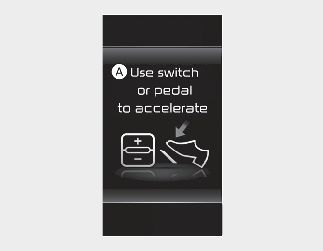
A: Use switch or pedal to accelerate
In traffic, your vehicle will stop if the vehicle ahead of you stops. Also, if the vehicle ahead of you starts moving, your
vehicle will start as well. In addition, after the vehicle has stopped and a certain time have passed, the warning message
will appear on the cluster. Depress the accelerator pedal or operate the (+) switch, (-) switch or ( ) switch to start driving.
) switch to start driving.
Warning road conditions ahead
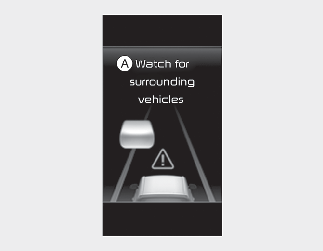
A: Watch for surrounding vehicles
In the following situation, the warning message will appear on the cluster, and an audible warning will sound to warn the driver of road conditions ahead.

Always pay attention to vehicles or objects that may suddenly appear in front of you, and if necessary, depress the brake pedal to reduce your driving speed in order to maintain a safe distance.
Collision warning
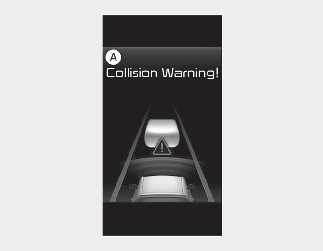
A: Collision warning!
While Smart Cruise Control is operating, when the collision risk with the vehicle ahead is high, the warning message will appear on the cluster, and an audible warning will sound to warn the driver. Always have your eyes on the road while driving, and if necessary, depress the brake pedal to reduce your driving speed in order to maintain a safe distance.

In the following situations, Smart Cruise Control may not warn the driver of a collision.
Always pay attention to road and driving conditions while driving.
-
The distance from the front vehicle is near, or the vehicle speed of the front vehicle is faster or similar with your vehicle
-
The speed of the front vehicle is very slow or is at a standstill
-
The accelerator pedal is depressed right after Smart Cruise Control is turned on

-
Smart Cruise Control does not substitute for proper and safe driving. It is the responsibility of the driver to always check the speed and distance to the vehicle ahead.
-
Smart Cruise Control may not recognize unexpected and sudden situations or complex driving situations, so always pay attention to driving conditions and control your vehicle speed.
-
Keep Smart Cruise Control off when the function is not in use to avoid inadvertently setting a speed.
-
Do not open the door or leave the vehicle when Smart Cruise Control is operating, even if the vehicle is stopped.
-
Always be aware of the selected speed and headway distance.
-
Keep a safe distance according to road conditions and vehicle speed. If the headway distance is too close during high-speed driving, a serious collision may result.
-
When maintaining distance with the vehicle ahead, if the front vehicle disappears, Smart Cruise Control may suddenly accelerate to the set speed. Always be aware of unexpected and sudden situations from occurring.
-
Vehicle speed may decrease on an upward slope and increase on a downward slope.
-
Always be aware of situations such as when a vehicle cuts in suddenly.
-
When you are towing a trailer or another vehicle, turn off Smart Cruise Control for safety reasons. If you tow a European spec trailer, the function may be limited.
-
Turn off Smart Cruise Control when your vehicle is being towed.
-
Smart Cruise Control may not operate properly if interfered by strong electromagnetic waves.
-
Smart Cruise Control may not detect an obstacle in front and lead to a collision. Always look ahead cautiously to prevent unexpected and sudden situations from occurring.
-
Vehicles moving in front of you with a frequent lane change may cause a delay in Smart Cruise Control reaction or may cause Smart Cruise Control to react to a vehicle actually in an adjacent lane. Always drive cautiously to prevent unexpected and sudden situations from occurring.
-
Always be aware of the surroundings and drive safely, even though a warning message does not appear or an audible warning does not sound.
-
If any other system's warning message is displayed or warning sound is generated, Smart Cruise Control warning message may not be displayed and warning sound may not be generated.
-
You may not hear the warning sound of Forward Collision-Avoidance Assist if the surrounding is noisy.
-
The vehicle manufacturer is not responsible for any traffic violation or accidents caused by the driver.
-
Always set the vehicle speed under the speed limit in your country.

-
Smart Cruise Control may not operate for a few seconds after the vehicle is restarted or the front view camera or front radar is initialized.
-
You may hear a sound when the brake is controlled by Smart Cruise Control.